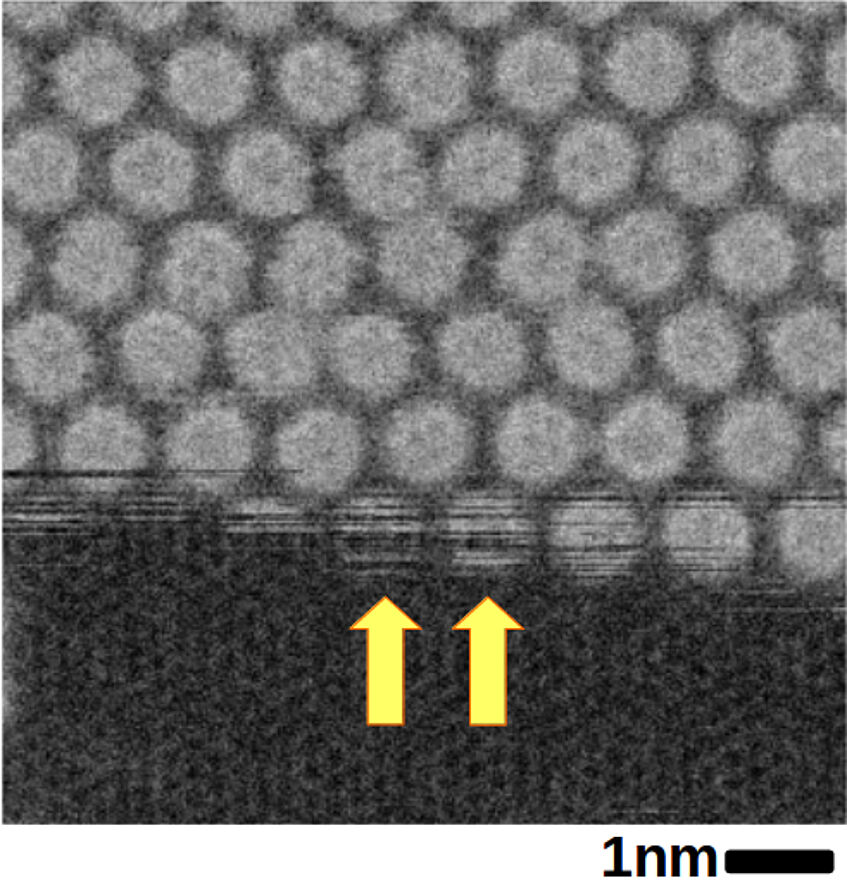«Structure-property relationship of 2D material modifications»
Two-dimensional materials, such as graphene, are one-atom or few-atom thick materials. In the ideal case, many of these materials are expected to have very unique electronic, mechanical, orchemical properties. However structural imperfections (e.g. missing atoms or impurities) have a strong influence on their properties. Tailored defects and/or impurities in 2D materials thus provide a means to fine tune their properties.
This project aims to make significant advances in understanding the structure-property relationships and control of material modifications at the atomic level. The main tool for the study is atomically resolved scanning transmission electron microscopy (STEM), which allows us to see individual atoms in 2D materials and also to study the dynamics of defects. (Underneath these lines, a computer model of graphene, a single layer of carbon atoms)
![[2dM01]](/fileadmin/_processed_/csm_netnet_cropped_7fc80fff51.png)
Breaking graphene
Defects, rather than the perfect lattice, determine the properties of any material. For example, materials always start to break at defects. Here is a computer simulation of a breaking 2D layer of graphene.
![[2dM02]](/fileadmin/_processed_/csm_braking_gif_547a5ea17b.gif)
![[2dM03]](/fileadmin/_processed_/csm_STEM_43ae43e2e2.jpg)
New Scanning Transmission electron microscope (STEM) at the University of Vienna
![[2dM04]](/fileadmin/_processed_/csm_perfect_graphene_3c22dc3ab4.png)
Perfect graphene
Scale bar: 2Å ( or 0.000 000 000 2m )
We employ powerful electron microscopes that can reveal the atomic structure of a material. We use it not only to study existing imperfections in a material, but also to introduce structural modifications by the irradiation.
![[2dM05]](/fileadmin/_processed_/csm_graphene_defect_6dea1da2b9.png)
STEM image of graphene with a line defect (grain boundary)
Random walk
![[2dM06]](/fileadmin/_processed_/csm_moving_defect_608ac58f7e.gif)
Random walk
Image sequence showing a „hole“ in thegraphene sample (two atoms are missing). The defect does not stay in one spot, but instead moves around during observation under the electron microscope. The defect performs a random walk driven by theirradiation.
A two-dimensional form of Silicon carbide formed while agitating atoms with the electron beam:
![[2dM07]](/fileadmin/_processed_/csm_beam_photo_6184da2cad.png)
Image of a two-dimensional Silicon carbide...
Structures under irradiation
Ordered structures can form under irradiation. In the video below these lines we can see how, throughirradiation, a cluster of silicon carbide forms.
![[2dM09]](/fileadmin/_processed_/csm_irradiation_gif_e6bcd7dca3.gif)
![[2dM08]](/fileadmin/_processed_/csm_beam_model_91371c201c.png)
...and corresponding diagram (in blue: Si atoms)
![[2dM09]](/fileadmin/_processed_/csm_yellow-thingy_cropped_c253ad1bfe.png)
We observed the behaviour of the molecules within Fullerene-Graphene sandwiches. That is, afullerene layer (the soccer-ball shaped molecules) between two sheets of graphene (the two-dimensional layers). Below these lines you can see the computer model of it.
![[2dM10]](/fileadmin/_processed_/csm_sandwich_df6f8776ad.jpg)
Fullerene-Graphene sandwich

Fullerene-Graphene sandwich
Fullerenes (the soccer-ball shaped molecules) were embedded between two graphene sheets and studied byatomic-resolution STEM. This way we could observe the diffusion and rotation of the molecules. Due to the motion of the fullerenes at the edge, they are only partially visible.
Research team
Principal Investigator: Prof. Jannik C. Meyer
Source material - Attribution
[2dM01] Graphene © Jannik Meyer, Universität Wien
[2dM02] Kotakoski © Jani Kotakoski & Jannik Meyer, Universität Wien
Phys. Rev. B 85, 195447 (2012) (this publication is not a result of the project; it was published before it started)
[2dM03] STEM © Gruppe Physik nanostrukturierter Materialien, Universität Wien
[2dM04] Graphene (2Å) © Gruppe Physik nanostrukturierter Materialien, Universität Wien
[2dM05] Graphene (5Å) © Gruppe Physik nanostrukturierter Materialien, Universität Wien
[2dM06] Hole in graphene sample © J. Meyer, C. Mangler, J. C. Meyer,
Nature Communications 5, 3991 (2014), published under CC-BY license
[2dM07] Cluster of Si Atoms © T. Susi et al.,
Scientific Reports 7, 4399 (2017), published under CC-BY license
[2dM08] Silicon carbide © T. Susi et al.,
Scientific Reports 7, 4399 (2017), published under CC-BY license
[2dM09] Structures under irradiation © T. Susi et al.,
Scientific Reports 7, 4399 (2017), published under CC-BY license
[2dM10] Fullerene-Graphene sandwich © Kimmo Mustonen/Jannik Meyer, Universität Wien
[2dM11] Fullerene layer between two graphene sheets © R. Mirzayev, K. Mustenen, et al., Science Advances 3, e1700176 (2017). Article published under CC-BY-NC license.
See also our press release (article published under CC-BY-NC license)
